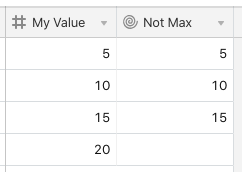Hi,
I am trying to find a way to find the value that is the second to the max value of multiple linked record using rollup. I can find the max value, but I am still unable to find a way to find the second to max value.
So if I have, 21840, 20194, 21664, I need to be able to work with the max(21840) and the second to max(21664).
I hope I have explained my situation properly and hopefully someone can help me.
Thanks in advance!




